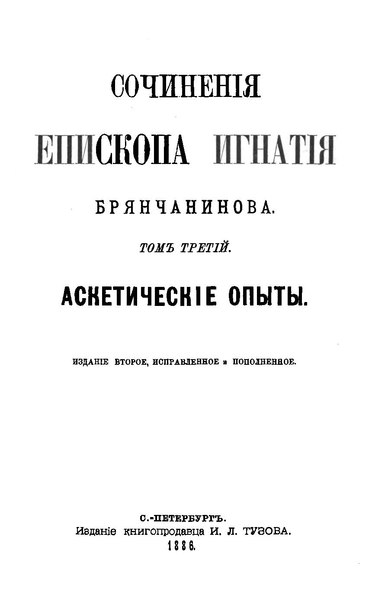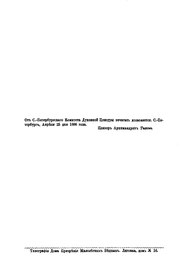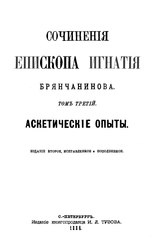File:Сочинения епископа Игнатия Брянчанинова. Том 3 из 5.pdf

Original file (895 × 1,381 pixels, file size: 13.04 MB, MIME type: application/pdf, 320 pages)
Captions
Captions
Summary edit
| Сочинения епископа Игнатия Брянчанинова
( |
||
|---|---|---|
| Author |
Епископ Игнатий (Брянчанинов), (1857—1861) |
|
| Title |
Сочинения епископа Игнатия Брянчанинова |
|
| Subtitle | Аскетические опыты | |
| Volume | 3 | |
| Edition | Второе, исправленное ипополненное | |
| Publisher |
Издание книгопродавца И. Л. Тузова |
|
| Description |
Содержание:
|
|
| Language | Russian | |
| Publication date |
1886 publication_date QS:P577,+1886-00-00T00:00:00Z/9 |
|
| Place of publication | Санкт-Петербург | |
| Source | Источник: Google Books | |
This file is in PDF format.
Portable Document Format (PDF) is a file format created by Adobe Systems for document exchange. PDF is used for representing two-dimensional documents in a manner independent of the application software, hardware, and operating system. Each PDF file encapsulates a complete description of a fixed-layout 2D document that includes the text, fonts, images, and 2D vector graphics which compose the documents. The best way to view PDF files is locally using a reader.Several free readers for every system are available at pdfreaders.org. Deutsch | English | español | français | македонски | Nederlands | português | русский | +/−
|
Licensing edit
This image is in the public domain because it is a mere mechanical scan or photocopy of a public domain original, or – from the available evidence – is so similar to such a scan or photocopy that no copyright protection can be expected to arise. The original itself is in the public domain for the following reason:
This tag is designed for use where there may be a need to assert that any enhancements (eg brightness, contrast, colour-matching, sharpening) are in themselves insufficiently creative to generate a new copyright. It can be used where it is unknown whether any enhancements have been made, as well as when the enhancements are clear but insufficient. For known raw unenhanced scans you can use an appropriate {{PD-old}} tag instead. For usage, see Commons:When to use the PD-scan tag. | |||||
| Public domainPublic domainfalsefalse |
This work was published on territory of the Russian Empire (Russian Republic) except for territories of the Grand Duchy of Finland and Congress Poland before 7 November 1917 and wasn't re-published for 30 days following initial publications on the territory of Soviet Russia or any other countries.
The Russian Federation (early Soviet Russia, RSFSR) is the historical heir but not legal successor of the Russian Empire, and the Russian Empire was not party to the Berne Convention (it was not country of Union for the protection of the rights of authors in their literary and artistic works), so according to article 5 of the Convention this work has no country of origin except:
¹ - Author who is not a national of a country of the Union but who has his habitual residence in a country of the Union, be assimilated to national of that country. The exclusive rights to this work do not extend on territory of the Russian Federation according to article 1256 of the Civil Code of the Russian Federation (details), because this work does not meet the requirements on the territory of publication, on the author's nationality, and on obligations for international treaties. If applicable, {{PD-Russia-expired}} should be used instead of this tag. This work is in the public domain in the United States because it was published (or registered with the U.S. Copyright Office) before January 1, 1929. |
File history
Click on a date/time to view the file as it appeared at that time.
| Date/Time | Thumbnail | Dimensions | User | Comment | |
|---|---|---|---|---|---|
| current | 20:14, 5 June 2012 |  | 895 × 1,381, 320 pages (13.04 MB) | Senapa (talk | contribs) |
You cannot overwrite this file.
File usage on Commons
The following page uses this file:
Metadata
This file contains additional information such as Exif metadata which may have been added by the digital camera, scanner, or software program used to create or digitize it. If the file has been modified from its original state, some details such as the timestamp may not fully reflect those of the original file. The timestamp is only as accurate as the clock in the camera, and it may be completely wrong.
| Short title |
|
|---|---|
| Author | Саинч Пгначьй [Ђиыоп ої Cахуацхц анд Чеѕномоѕфе] |
| File change date and time | 06:03, 5 June 2012 |
| Date and time of digitizing | 06:03, 5 June 2012 |
| Date metadata was last modified | 06:03, 5 June 2012 |
| Conversion program | Google Books PDF Converter (rel 2 28/7/09) |
| Encrypted | no |
| Page size |
|
| Version of PDF format | 1.5 |



